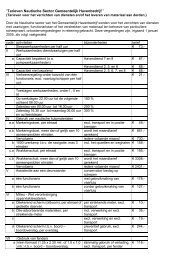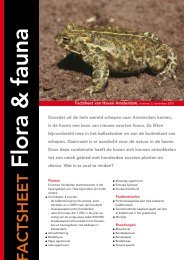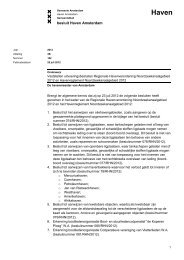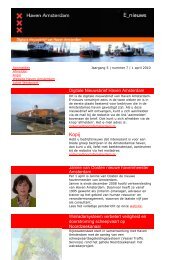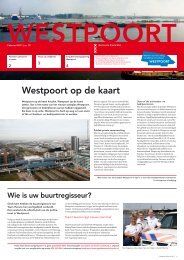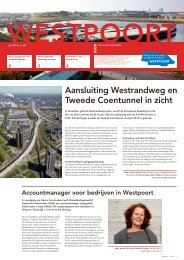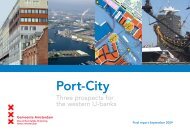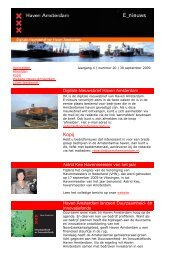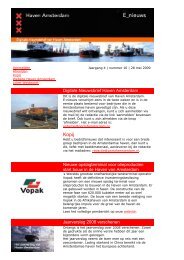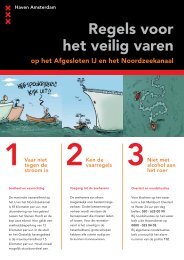FA C T S H E E T
FA C T S H E E T
FA C T S H E E T
You also want an ePaper? Increase the reach of your titles
YUMPU automatically turns print PDFs into web optimized ePapers that Google loves.
ACTSHEET Energy<br />
Port of Amsterdam Factsheet, number 2, November 2010<br />
Amsterdam stands out as an energy port. Europe and coun<br />
tries in other parts of the world have a great need for energy.<br />
Port of Amsterdam is a leader for delivering the raw materials<br />
to satisfy this need. Much of it is fossil energy from oil pro<br />
ducts and coal. At the same time, the proportion of sustaina<br />
ble energy is growing in Amsterdam.<br />
Port in transition<br />
Port of Amsterdam’s goal for 2020 is to be<br />
among the top sustainable ports in Europe.<br />
To achieve this, the organisation reserves<br />
physical and environmental space, and<br />
invests in the construction of facilities to<br />
partly reduce the fossil share of the energy<br />
mix in favor of sustainable forms. According<br />
to expectations, by 2020 around 20% of the<br />
fossil fuel will have given way to sustainable<br />
energy.<br />
Energy from fossil fuel<br />
Oil products and coal account for 70% of<br />
transhipments in Port of Amsterdam. A small<br />
portion of this is used to generate energy for<br />
the city of Amsterdam; the major part is for<br />
the European and world markets.<br />
Coal<br />
■ During the past few years, Amsterdam has<br />
grown to become one of the world’s leading<br />
ports for coal.<br />
■ After Rotterdam, Amsterdam is the second<br />
largest coal transhipment port in Europe.<br />
■ Coal represents almost 50% of the electricity<br />
market in north-west Europe. Over the next<br />
20 years, coal transport is expected to increase<br />
because of:<br />
- a continuing need for energy<br />
- rising imports of coal by Europe due to<br />
mine closures in Germany, England and (in<br />
the future) Poland and the Czech Republic;<br />
- the intended construction of new, cleaner<br />
coal-fired power stations in Germany and<br />
the Netherlands.<br />
■ For Amsterdam, this will mean an increase
from 14.7 million tonnes of coal in 2007 to an expected<br />
24 million tonnes in 2020. By investing in intensive<br />
space utilisation, the increasing volume of coal<br />
transhipments can be housed at existing locations,<br />
without the need for additional space.<br />
■ Port of Amsterdam continues to invest in facilities for<br />
the growing transhipment of coal. One example is a<br />
lighter dock ahead of the lock system (at the Averijhaven<br />
in IJmuiden); another, the construction of a<br />
second large lock so that Amsterdam can continue to<br />
receive large ships.<br />
■ Coal is becoming a cleaner fuel through the application<br />
of clean coal technology (gasification). To further<br />
reduce emissions, research is being conducted into<br />
underground CO 2 storage. Worldwide coal stocks are<br />
still plentiful. Moreover, the next few years will see<br />
some of the coal replaced with biomass, which will cut<br />
CO 2 emissions even more.<br />
Transhipments of coal (x 1,000 tonnes)<br />
1995 4,760<br />
2000 11,289<br />
2005 12,597<br />
2009 14,592<br />
2020 24,000 (projected)<br />
Electricity from coal<br />
In Amsterdam, coal is not only transhipped for transport<br />
to the hinterland, 1.6 million tonnes are also used<br />
to power Nuon’s local Hemweg power station. This<br />
coal is transported directly from the OBA bulk terminal<br />
via a covered conveyor belt to the Hemweg plant.<br />
(For production figures, see “Production” in this fact<br />
sheet).<br />
Sustainable transhipment<br />
The coal transhipment companies seek to transport<br />
coal in the cleanest possible manner. They have taken<br />
active measures to prevent excessive dust, such as<br />
using closed-in conveyor belts, spraying the coal, and<br />
covering the coal mounds with a layer of cellulose.<br />
In addition to complying with permit requirements,<br />
Rietlanden/EDF already has a dust monitoring system,<br />
and OBA is currently installing one. This system enables<br />
companies using the facility to take immediate<br />
action if dust limits are exceeded. The system is also<br />
able to predict sudden increases, which means the<br />
burden on the environment is kept to a minimum.<br />
Coal transhipment companies in Port of Amsterdam:<br />
Bulk Terminal Amsterdam (OBA): 1 site<br />
Rietlanden/EDF: 2 sites<br />
Oil<br />
■ During recent years, Amsterdam has experienced<br />
huge growth as regards oil products. It is now one of<br />
the largest petrol ports in the world.<br />
■ Amsterdam specializes in blending petrol, as well as<br />
providing substantial storage for diesel and kerosene.<br />
■ Much of the oil comes from Russia, the UK and Rotterdam.<br />
It is stored and, in many cases, blended, after<br />
which it is transported further to Europe’s hinterland,<br />
or exported, mainly to the United States and West<br />
Africa.<br />
■ Schiphol Airport receives around half the kerosene<br />
it needs via a 16-kilometre underground pipeline<br />
connecting the airport to Oiltanking Amsterdam.<br />
■ Despite the worldwide use of biofuels and electric<br />
transport, the demand for the transhipment of oil<br />
products through Port of Amsterdam and their storage<br />
is expected to continue to grow until 2020. In the<br />
case of transhipment, the projected figure for 2020 is<br />
50 million tonnes.<br />
Transhipment of oil products (x 1,000 tonnes)<br />
1995 7,094<br />
2000 11,207<br />
2005 19,131<br />
2009 35,162<br />
2020 50,000 (projected)<br />
Oil terminals in Port of Amsterdam:<br />
Oiltanking<br />
Eurotank<br />
BP Terminal<br />
NuStar<br />
Vopak<br />
Sustainable energy<br />
Amsterdam expressly offers space for sustainable<br />
energy at the port. Port of Amsterdam makes sites<br />
available for the transhipment and production of<br />
sustainable energy, having all the necessary facilities<br />
for transhipment. With good accessibility by sea and<br />
excellent connections to the hinterland, Amsterdam<br />
is also favourably situated for the receipt and delivery<br />
of raw materials used in the production of sustainable<br />
energy.
Bioenergy<br />
■ Bioenergy is the collective name for energy produced<br />
from organic (plant and animal) material.<br />
Biofuel is a liquid energy (bioethanol and biodiesel)<br />
used as fuel for combustion engines, the raw materials<br />
being agricultural crops and residues.<br />
Biomass refers to the biodegradable fraction of agricultural<br />
crops, agricultural, forestry and similar residues,<br />
and waste. It is used as fuel for power stations.<br />
■ Two biodiesel factories are now situated at Port of<br />
Amsterdam, namely Greenmills and Vesta Biofuels<br />
Amsterdam.<br />
Greenmills’ biodiesel factory intends to produce<br />
sustainable biofuels and green electricity from organic<br />
residues, such as used frying oil, and fruit, vegetable<br />
and garden waste. According to expectations, Greenmills<br />
will convert 100,000 tonnes of organic waste<br />
each year into 100,000 tonnes of sustainable biodiesel<br />
(about 115 million litres) and 25 million m 3 of biogas.<br />
From the biogas, it is possible to generate 5 megawatts<br />
of green electricity, enough to fully satisfy the<br />
needs of 10,000 to 12,500 households. The first part<br />
of the factory will officially begin operating in January<br />
2011, and the rest by the end of the year.<br />
On the south side of the Amerikahaven, Vesta Biofuels<br />
Amsterdam will begin producing biodiesel in<br />
May 2011. Its factory has a flexible design and uses<br />
a wide variety of raw materials, from rapeseed oil to<br />
residue flows. The capacity of the factory is 200,000<br />
tonnes of biodiesel a year (roughly 230 million litres).<br />
Icova waste material management<br />
Icova manufactures some 60,000 tonnes of fuel<br />
pellets from industrial waste, corresponding to the<br />
annual energy needs of some 9,500 households. The<br />
fuel pellets are sold mainly to Sweden, and used there<br />
for city heating.<br />
■ With various market parties at the port and elsewhere,<br />
Port of Amsterdam is discussing the further development<br />
of the storage, transhipment and manufacturing<br />
of bioenergy in the port area.<br />
The port’s annual targets for transhipment are:<br />
2010 2015 2020<br />
Total bioenergy 1 mln ton 5 mln ton 13.5 mln ton<br />
Biofuels 1 mln ton 2 mln ton 3.5 mln ton<br />
Biomass 0.5 mln ton 3 mln ton 10 mln ton<br />
By reaching these targets, Port of Amsterdam will<br />
acquire a substantial share of the market in north-west<br />
Europe for the transhipment of biomass.<br />
■ The port is aware of bioenergy’s downside (food for<br />
fuel and biodiversity), as well as the public debate<br />
on the issue. Accordingly, it is involved in certification<br />
and the creation of quality labels for biomass<br />
and biofuels. One group to which Port of Amsterdam<br />
belongs is Taskforce 40 of the International Energy<br />
Agency, with the aim of creating a sustainable bioenergy<br />
market.<br />
Wind energy<br />
The other form of sustainable energy (alongside<br />
bioenergy) that Port of Amsterdam focuses on is wind<br />
energy.<br />
■ Inside the port area is a large wind farm with a capacity<br />
of 125 million kWh, enough to meet the electricity<br />
needs of approximately 40,000 households. Over<br />
time, this will grow to 80,000.<br />
■ The ambition of the Amsterdam port region is to play<br />
a major role in the development of very large offshore<br />
wind farms. Expectations are that in the next ten or<br />
twenty years north-west European seaports will be<br />
the base for the installation of several thousand wind<br />
turbines. The wind turbines and related components<br />
will be transported in huge numbers from overseas<br />
and transhipped using heavy equipment. In addition,<br />
the components will be assembled in the Amsterdam<br />
region, after which special-purpose ships will install<br />
the wind turbines in the North Sea.<br />
IJmuiden has already been the base for the installation<br />
of two large wind farms, together comprising<br />
120 wind turbines with a combined capacity of<br />
360 megawatts. Through regional co-operation and<br />
harmonization of logistics options, Port of Amsterdam<br />
is developing a common approach to the market in<br />
offshore wind farms.<br />
Energy <strong>FA</strong>CTSHEET
The Amsterdam port region has the following targets<br />
for offshore wind turbines:<br />
2010: 10 units a year<br />
2015: 200 units a year<br />
2020: 500 units a year<br />
Waste = Raw Material<br />
Port of Amsterdam, Municipality of Zaanstad and<br />
Amsterdam’s Department of the Environment and<br />
Buildings Inspectorate have initiated the project<br />
Afval = Grondstof (Waste = Raw Material). What one<br />
company regards as residue flows and waste material,<br />
another company nearby might see as an interesting<br />
raw material or source of energy. With Afval = Grondstof,<br />
Port of Amsterdam intends to give a powerful<br />
boost to an efficient and high-quality recycling of raw<br />
materials and residue flows by companies in the Amsterdam-Zaanstad<br />
port region. Companies that want<br />
to exchange residue can obtain support for project<br />
management, subsidy applications, and location of<br />
the right experts.<br />
Production<br />
Within Port of Amsterdam, energy is produced at different<br />
locations.<br />
Greenmills, Vesta Biofuels and Icova<br />
(see the section “Bioenergy” in this fact sheet).<br />
Hemweg power station<br />
Nuon’s Hemweg power station, cofired by gas and<br />
coal, has a capacity of 1,229 megawatts, enough<br />
to satisfy all the electricity needs of 2.5 million to 3<br />
million households. In practice, this figure is lower as<br />
the plants do not operate round-the-clock (see the<br />
section “Coal”). With the aim of achieving sustainable<br />
generation of electricity, Nuon is drawing up plans for<br />
cofiring approximately 20% biomass at the coal-fired<br />
plant.<br />
City of Amsterdam Waste and Energy Company (AEB)<br />
■ AEB generates energy by incinerating waste, 48%<br />
of the supplied waste being biomass. As the waste<br />
absorbs the same amount of CO 2 during growth as is<br />
released on incineration, the process is therefore CO 2 -<br />
neutral.<br />
■ The power stations have a total capacity of 124<br />
megawatts and produce 1 million megawatt hours of<br />
electricity each year. This is sufficient electricity for<br />
some 320,000 households (75% of Amsterdam’s total).<br />
■ Amsterdam’s trams and underground, city lighting,<br />
City Theatre, Music Theatre and City Hall all make use<br />
of electricity generated from waste.<br />
■ Apart from electricity, the method also produces city<br />
heating for Amsterdam households as well as hot<br />
water. Per home, the reduction in CO 2 emissions is<br />
over 60%. Commencing in 2008 and ending in 2025,<br />
roughly 35,000 homes in Amsterdam-Noord and<br />
Amsterdam Nieuw-West are going to receive city<br />
heating via a connection to AEB, resulting in a future<br />
CO 2 reduction of 42 million kilos. This is comparable<br />
to almost 24 million m 3 gas, or the total emissions of<br />
13,000 cars each year.<br />
■ At year-end 2009, 70 companies in Westpoort were<br />
also already linked to this city heating network. Port<br />
of Amsterdam supports the connection of even more<br />
companies in Westpoort.<br />
Source: Port of Amsterdam, Nuon, AEB, Icova, Greenmills, J&S<br />
Colofon <strong>FA</strong>CTSHEET is a publication of Port of Amsterdam<br />
P.O. Box 19406, 1000 GK Amsterdam, the Netherlands<br />
Tel: +31 20 523 45 60, Fax: +31 20 523 40 60,<br />
E-mail: marketing@portofamsterdam.nl, Website: www.portofamsterdam.nl.<br />
Port of Amsterdam is a company of the city of Amsterdam.



